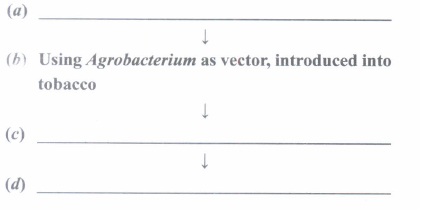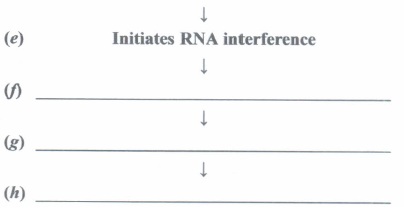CBSE 12th Standard Biology Subject Biotechnology and its Applications Case Study Questions 2021
By QB365 on 21 May, 2021
QB365 Provides the updated CASE Study Questions for Class 12 Biology, and also provide the detail solution for each and every case study questions . Case study questions are latest updated question pattern from NCERT, QB365 will helps to get more marks in Exams
QB365 - Question Bank Software
CBSE 12th Standard Biology Subject Biotechnology and its Applications Case Study Questions 2021
12th Standard CBSE
-
Reg.No. :
Biology
-
Two of the steps involved in producing nematoderesistant tobacco plants based on the process of RNAi are given. Write the missing steps in proper sequence in the blank spaces a, c, d, f, g and h provided.

 (a)
(a) -
A child is born with a very weak immune system due to the deficiency of an enzyme; it is a hereditary disorder. The doctor explained the available methods of treatment and advised for gene therapy.
(a) Identify the deficient enzyme and the cause of it.
(b) What is gene therapy?
(c) ame two other methods available for the treatment of this disease.(a) -
Read the following and answer any four questions from (i) to (v) given below:
Golden rice was engineered from normal rice by Potrykus and Beyer in the 1990s. The typical golden colour is due to the production of \(\beta\) carotene a precursor of vitamin - A. Golden rice differs from its parental strain by the addition of three \(\beta\) carotene genes. These included two genes from daffodil plant and third from a bacterium. The incorporation of these genes allows the rice plant to modify certain metabolic pathways in its cells to produce \(\beta\)-carotene.
(i) Due to genetic modification golden rice plants produce and store \(\beta\) - carotene in(a) stem (b) seed (c) leaves (d) all of these (ii) Transfer of genes to produce golden rice is achieved by
(a) Agrobacterium (b) pBR322 (c) \(\lambda \text { -phage }\) (d) gene gun (iii) In golden rice two genes were taken from
(a) Narcissus sp. (b) Erwinia (c) Coryza sativa (d) none of these (iv) Golden rice is helpful to fight against disease caused by the deficiency of
(a) Vitamin Bl2 (b) Vitamin C (c) Vitamin A (d) Vitamin D. (v) Golden rice was genetically engineered by
(a) Fire and Mello (b) Potrykus and Beyer (c) Banting and Best (d) Kohler and Milstein (a) -
Read the following and answer any four questions from (i) to (v) given below:
Transgenic animals can serve as factories that in some cases, may produce large amount of proteins more efficiently. Transgenic mice have been engineered to express human antibodies by introducing large segment of human DNA encoding human immunoglobulin genes. In transgenic large animals such as cow or sheep proteins of pharmaceutical value can be produced in large quantities in milk which is later purified. Transgenesis can be used to alter many phenotypic properties including growth rate, fat composition, milk production, hair texture, etc.
(i) The production of transgenic animals includes(a) identification and separation of desired gene (b) combining the desired gene with appropriate vector (c) introduction of vector in cells, tissues or embryos (d) all of these. (ii) In transgenic animals, i.e., cow and sheep proteins of pharmaceutical value are produced in large quantities in the
(a) blood (b) accumulated fat (c) mammary glands (d) none of these. (iii) Mouse is mostly preferred animal for studies on gene transfer because
A. short oestrous cycle
B.long gestation period
C.Short generation time
D.Production of one or two offspring per pregnancy(a) both (A) and (C) (b) both (A) and (B) (C) Only D (d) both (C) and (D). (iv) Transgenic genes alter many phenotypic properties including
(a) growth rate (b) fat composition (c) milk production (d) all of these (v) Assertion : Transgenic mice have been engineered to express human antibodies.
Reason : Large segment of human DNA encoding human immunoglobulin have been transferred to mice.(a) Both assertion and reason are true and reason is the correct explanation of assertion. (b) Both assertion and reason are true but reason is not the correct explanation of assertion. (c) Assertion is true but reason is false. (d) Both assertion and reason are false (a) -
Read the following and answer any four questions from (i) to (v) given below:
European patent office, Munich granted patent for fungicidal use of neem oil, to firm of WR. Grace & Co. It was challenged by Vandana Shiva and Ajay Phadke who had researched neem in India and it was shown that Grace & Co. had not unveiled any novelty factor in neerns properties. Ethics include rules of conduct by which a community regulates the behaviour and decides as to which activity is lawful and which is not.
(i)_________ allow private, monopoly right over animals and plants.(a) Bioethics (b) Biopatents (c) Bioweapons (d) Either (a) or(b) (ii) Which of the following is not a criteria of granting patent?
(a) Novelty (b) Utility (c) Non-obviousness (d) Prior art (iii) On which plants patents have been granted?
(a) Piper nigrum (b) Brassica campestris (c) Punica granataum (d) All of these (iv) Rules of conduct that may be used to regulate our activities in relation to biological world are included in
(a) bioethics (b) biopiracy (c)biopatents (d) biowar (v) Assertion : Genes and cells should not be patented.
Reason : Genes and cells are not an inventions(a) Both assertion and reason are true and reason is the correct explanation of assertion (b) Both assertion and reason are true but reason is not the correct explanation of assertion (c) Assertion is true but reason is false (d) Both assertion arid reason are false (a)
Case Study Questions
*****************************************
CBSE 12th Standard Biology Subject Biotechnology and its Applications Case Study Questions 2021 Answer Keys
-
(a) Isolation of nematode-specific gene.
(c) Production of sense and anti-sense RNA in the host.
(d) Formation of double-stranded RNA.
(f) Silencing of specific mRNA of nematode.
(g) Host expresses the interfering RNA.
(h) Parasite/nematode cannot survive in the host. -
(a) (i) Adenosine deaminase (ADA) is the deficient enzyme.
(ii) It is caused by the deletion of the gene coding for the enzyme.
(b) Gene therapy refers to a collection of methods that allows the correction of a gene defect that has been diagnosed in a child or embryonic stage.
(c) (i) Enzyme-replacement therapy.
(ii) Bone marrow transplantation. -
(i) (b) : Golden rice is a transgenic variety of rice (Oryza sativa) which contains good quantities of\(\beta\)-carotene (provitamin A - inactive state of vitamin A).\(\beta\)-carotene is a principal source of vitamin A. Since the grains (seeds) of the rice are yellow in colour due to \(\beta\)-carotene, the rice is commonly called golden rice.
(ii) (a) : Foreign genes were inserted into the genome of a tempera,te rice variety by using Agrobacterium tumefaciens as the vector.
(iii) (a) : In golden rice, two genes for \(\beta\)-carotene were taken from daffodil (Narcissus sp.) and one gene from a bacterium Erwinia.
(iv) (c) : Golden rice is rich in\(\beta\)-carotene which is a precursor of vitamin A.
(v) (b) : Prof. Ingo Potrykus and Peter Beyer produced genetically engineered rice by introducing three gene associated with synthesis of carotene. The grains (seeds) of transgenic rice are rich in provitamin. -
(i) (d)
(ii) (c)
(iii) (a) : Mouse has short gestation period and it produces several number of offspring per pregnancy.
(iv) (d)
(v) (a) -
(i) (b) : A patent is the right granted by a government to an inventor to prevent others from commercial use of his invention. Biopatent system allows private, monopoly rights over cells, genes, animals and plants.
(ii) (d) : Patents are supposed to satisfy three criteria of novelty, non-obviousness and utility.
(iii) (d) : Patents have been taken out on plants such as black pepper, basmati rice, Indian mustard, Pomegranate, Turmeric and neem.
(iv) (a)
(v) (a) : Genes, cells, micro-organisms, plants and animals are not inventions and hence must not be patented.
Case Study Questions






































